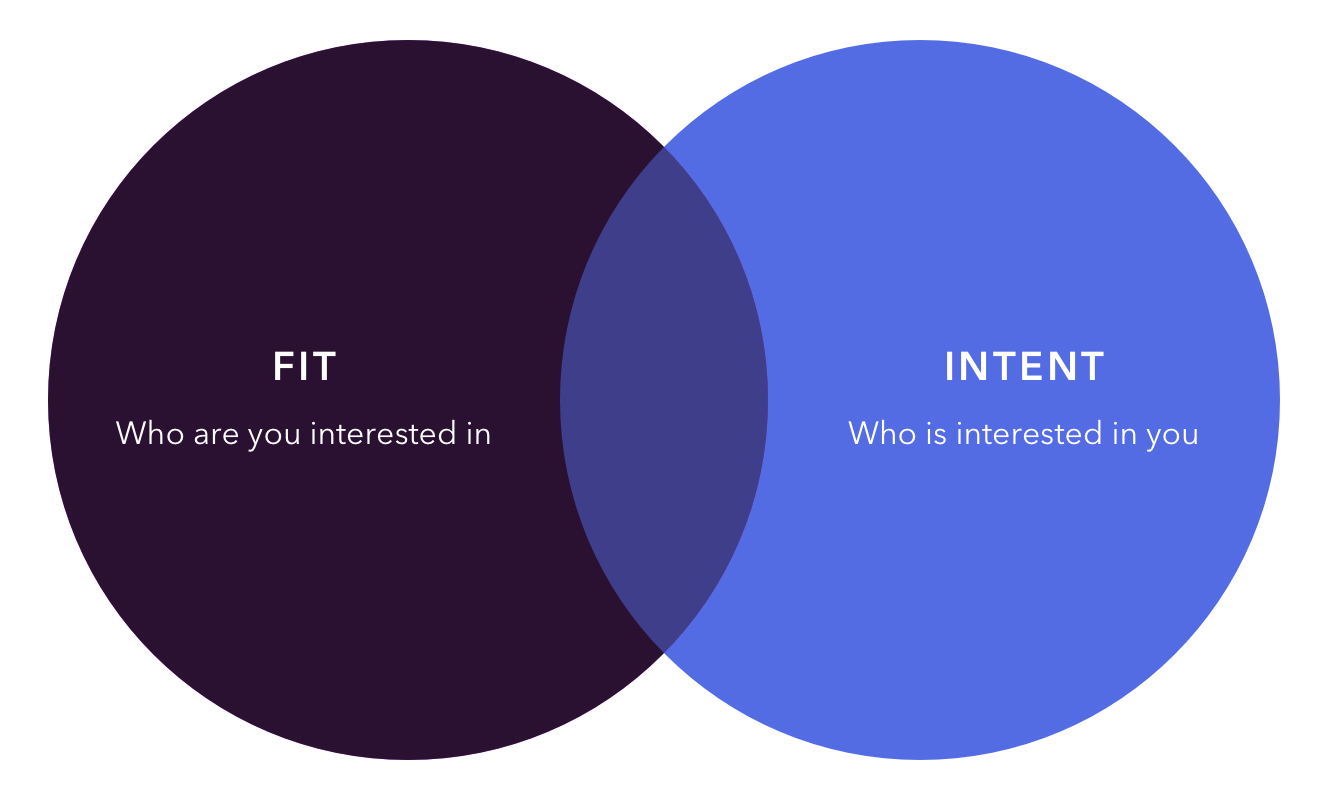What is 2D lead scoring?
If you're wondering what 2D lead scoring is, you've come to the right place. Here's how we define it at Clearbit.
Two-dimensional (2D) lead scoring uses two types of data to score leads — fit and intent — rather than qualifying with just one of these aspects.
- Fit indicates whether a lead is a good type of customer for your company. It’s typically based on the company’s firmographic data — details like its industry, country, and number of employees — and how close they match your ideal customer profile.
- Intent indicates a lead’s interest in you, and their likelihood to buy. It’s based on behavioral data and engagement, like a demo request, a product signup, an eBook download, or repeated website visits.

2D scoring calculates a lead’s fit and intent, then weighs the two and decides whether to send that lead to sales, keep it on a self-serve path, send a nurture email sequence, etc.
This doesn’t mean fit and intent are a 50-50 split in terms of importance. High-growth SaaS companies typically give more weight to fit scores than intent scores when they’re deciding which leads to send to sales. As we’ll discuss, this is a way to preserve expensive sales resources and use them efficiently.
The standards for what makes a good-fit lead can change over time, and companies can raise or lower the threshold based on sales team capacity. Similarly, changing intent score thresholds is a way to “open and close the tap” for your sales team. When they’re slammed, they should focus on working high-fit, high-intent leads. When they’re bored and flying paper planes across the office, you can send them a wider range of opportunities — for example, warm-ish leads that could use some sales outreach to grow intent.
These thresholds for fit and intent, as well as their relative weight, can change based on the size of the sales team, how many leads each rep can handle, and their training to work specific types of leads (e.g., inbound versus outbound conversations, different segments, etc.).
Let’s illustrate these dynamics with an example.
2D lead scoring at Clearbit
Clearbit calculates a lead’s fit score using data like industry, employee count, Alexa rank, and title. We also collect their intent signals, including demo requests and everything leading up to one.
We watch accounts that have not yet raised their hand to talk to sales, but who are otherwise engaging with our marketing material — reading our content, signing up for free trials, clicking on our ads, watching webinars, and visiting our website’s pricing page. When a lead racks up enough engagement points to be considered warm, we send them to sales. And since we’re using 2D lead scoring, those leads also need to meet a certain fit threshold.
But how many engagement points are “enough” to make it to sales? This standard changes over time, and we’re constantly refining it. In the early days, the sales team at Clearbit stayed very small. Reps focused on talking to hand raisers, using fit score to prioritize among them. But when Clearbit started scaling and the sales team grew, we had new capacity to do outbound and reach out to marketing-sourced leads that hadn’t yet requested a demo.
Our marketing team works closely with sales to figure out which of these warm leads are ready for that outbound, and which ones need a little more “warming up” with nurture campaigns. It’s an ongoing process of tightening and loosening the tap based on the sales team’s feedback, and our company’s current strategy and growth goals.
Clearbit’s 2D scoring: Examples of fit and intent data used
At Clearbit, we qualify leads using fit scores and intent scores. Intent scores take into account the type of action, with different weight for different actions, but the time horizon also matters. If a company visits our site five times in two days, that may indicate more intent than visiting five times over three years.
Make fit scores the gatekeeper for sales attention
One rule of thumb for an efficient 2D scoring system is to make fit scores (not intent scores) the primary gatekeeper for sales attention.
Here’s why. For SaaS companies that want to grow quickly, It can be tempting to talk to high-intent companies that keep knocking down your door, because they seem like low-hanging fruit. But they can distract sales from spending time with companies that are a much better fit and haven’t expressed much interest yet. It’s usually more efficient to let your AEs, senior sales talent, or dedicated teams (ABM, BDRs, etc.) focus on high-fit prospects, even if they have low intent.
Good salespeople can create and develop intent where there was none. You can’t change a fit score, but you can influence purchase intent via sales and marketing.
Taking this rule of thumb a little further — if you have the sales resources to do so — consider giving more weight to account fit than to individual intent and fit.
Legendary CRO Mark Roberge puts it well on the State of Demand Gen podcast:
"If the intern at a great-fit company subscribes to your blog, a good salesperson will navigate up from the intern to the decision maker. A demo request from a non-fit company will distract the AE from working with the intern at a perfect company." – Mark Roberge
So if you’re selling a design product, the "Entry-Level Design Intern" from an A+, perfect-fit company could be worth a sales connection. Even if they have no purchasing power, an AE can use them as the entry point to develop a relationship with the entire account. This intern lead is more valuable than a decision maker like the VP of Design from a poor-fit company, even if that VP is eager to talk to you.
The bottom line is, sales should have a high standard for fit score. For marketers, this means they should make fit the central focus when they design acquisition campaigns. As they drum up a lot of new leads at the top of the funnel, it’s important to get the right profile in the door. You can’t change a lead’s fit once they’re sitting in your living room.
So fit is a crucial piece, but intent has earned its place in the 2D score, too. Intent helps sales prioritize within a list of high-fit leads, and it’s another lever to play with if they need more leads to work. It also helps them do more timely, effective outreach — it can signal when it’s a good moment to reach out, and what to talk about when they do (e.g., mention the webinar topic that the lead just watched).
While marketers should focus on fit when designing acquisition campaigns, they should focus on influencing intent when they design post-acquisition nurture campaigns that push people down the buyer’s journey. The goal is to increase likelihood to buy, using personalized content and messaging that really resonates.
What does a 2D lead score look like?
Keep a 2D lead score’s fit and intent score separate instead of combining them into one blanket score (e.g. “this lead is an 87”).
Remember that intent scores can move up (or down) over time, while fit stays the same. And combining the two could let a low-fit lead sneak into a sales conversation, because their high intent score could obscure their low fit.
One approach we’ve seen at Clearbit is to use two fields in a lead score, where fit is represented by a letter grade and intent is represented by a number score. Again, the fit letter stays stable over time, while the intent score can change.
To illustrate:
- A grade for high fit, and a 2 score for low intent = A2
- D grade for bad fit, but a 10 score for high intent = D10
Instead of talking to the D10, sales should spend their time nurturing the A2 into an A10. These fields can be calculated in Salesforce or in a lead scoring tool.
Speaking of lead scoring tools, MadKudu’s approach is to use two numerical scores: one for Customer Fit and one for Likelihood to Buy, on a scale of 0-100.
In the image below, you can see a score for each field, along with itemized Customer Fit Signals (e.g., Director title, Company uses Salesforce) and Likelihood to Buy Signals (e.g. Started session 6 times on 7/19/2021).
Itemizing scores in this way helps sales and marketing understand a lead’s context and personalize outreach accordingly.
Keeping fit and intent separate in 2D lead scoring will help you send the right lead down the right buyer’s journey — and ensure you don’t distract sales reps, no matter how many flames there are. 🔥 🔥 🔥
Want to learn more about lead scoring for B2B SaaS and product-led companies? Check out Clearbit's Modern Guide to Lead Qualification.

